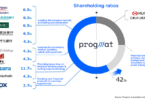Today Provenance Blockchain Inc announced that it completed a $20 million security token offering (STO) for the permissioned provenance.io lending platform. Provenance was developed by Figure Technologies which was started by Mike Cagney, the former CEO of SoFi. A month ago Figure announced a $65 million Series B round, bringing its total funding to $120 million.
The STO investors included participation from blockchain and traditional technology investors, but none are named in the announcement.
Figure Technologies’ advisors include former SEC chairman, Arthur Levitt, former FDIC Chairwoman Sheila Bair, former Digital Asset CEO Blythe Masters, Global Atlantic CIO Anup Agarwal and Andy Sandler, founder of Buckley Sandler.
Figure Technologies has spun out the provenance.io network and Provenance Blockchain Inc (PBI) as the network administrator. PBI “serves at the pleasure of the Hash holders,” says the whitepaper. Hash is the name of the token that will drive the network. Figure retains 71% of Hash stock. 5% went to stakeholders and 24% to PBI, some of which was sold in the STO.
Provenance is positioning itself as a blockchain for end-to-end loan transactions. So the blockchain will be used to originate loans, to receive loan payments, to buy and sell loans in the secondary market, to finance loans and to securitize loans. The emphasis is on the securitization aspect which is a $3 trillion market with significant room for cost savings.
“This is a seminal moment for the blockchain industry in financial services,” said Sheila Bair, former Chairwoman of the FDIC. “Provenance.io has the potential to bring massive improvements to the industry, across asset originators, the buy and sell side, as well as regulatory benefits and better consumer protections. In particular, it will provide loan-level transparency around the quality of securitized assets and a clear, unalterable record of ownership—two things that were sorely missing during the financial crisis.”
Figure Technologies created a retail loan product for homeowners to borrow online against their home’s equity. From September 2018 to February this year the company advanced 1,500 loans. A key intent of the retail operation is to use the Provenance blockchain and prove its viability. By the middle of this year, it plans to invite other companies to originate loans using the Provenance platform.
There are some hints that ambitions may extend beyond loans. Firstly, the whitepaper has a page devoted to inefficiencies in “financial services”, not just the mortgage loan market. It includes a list of valuations for custodial banks. Plus the trademark registration for Provenance includes “computer software for managing digital assets; computer software for completing financial and investment transactions for equities”.
Governance and Technology
It’s hard to see how Provenance won’t be controlled by Figure until its share of Hash drops below 50%. Figure will never vote more than the equivalent of non-Figure owned Hash. Which means Figure will have half of the votes for a long time, and all voting is majority plus one. Even once Figure’s share of Hash drops below 50%, Provenance may still control some Hash.
The blockchain itself is unusual in several ways. The whitepaper states that it was built in-house but uses the consensus module from Hyperledger. The question is whether big companies will entrust large sums of money to a platform where the technology isn’t battle hardened through open source.
The platform is publicly accessible but permissioned to comply with Know Your Customer (KYC) and Anti Money Laundering (AML) procedures. A large proportion of the KYC/AML checks are performed by “omnibus banks” which also provide settlement services.
Both data and files, including full asset documentation, are stored on the ledger. This is in contrast to the more common practice of storing a hash of the document to prove it hasn’t been edited, with the source files securely stored externally but available to permissioned parties. This is especially the practice where documents store personal data as in this case.
Legal ownership is determined solely on-chain enabling instant transfers. Settlement is instant, but the money will need to be deposited at the omnibus bank or sent to it in advance.
Members don’t need to use Hash for transactions. According to the whitepaper: “When members transact in fiat, the omnibus bank uses an equivalent amount of Hash, passed instantly between transacting members, to memorialize fiat transactions on the blockchain.”
Nodes put up a stake of Hash to ensure good behavior such as not tampering with the contents of the server. But they don’t validate transactions. Figure says it has established an initial node group that “include leading buy and sell-side financial firms and related firms from the financial ecosystem”. But none are named. This contrasts with most enterprise blockchains that explicitly avoid competitors hosting your data, even if it is encrypted.
The team behind Figure appear to have a strong execution track record, something that’s much needed in the blockchain space. But the whitepaper raises many questions. Figure responded to some questions below:
Can you disclose any names of node operators? Only to members on Provenance
Who is your current omnibus bank? We disclose this only to members on Provenance
Is it a blockchain? Is all data stored on all nodes? Yes. Provenance is a proof of stake, permissioned blockchain. Currently, data is stored across all nodes. As we expand geography, it is likely that certain nodes will hold certain geographic data. For example, US nodes won’t hold European consumer data, etc.
How / where does consensus and validation work? Distributed stakeholder. The underpinning is hyperledger’s consensus model.
Are there privacy issues with storing documents on-chain? Everything is encrypted and permissioned at the field level.
This article has been updated and expanded






